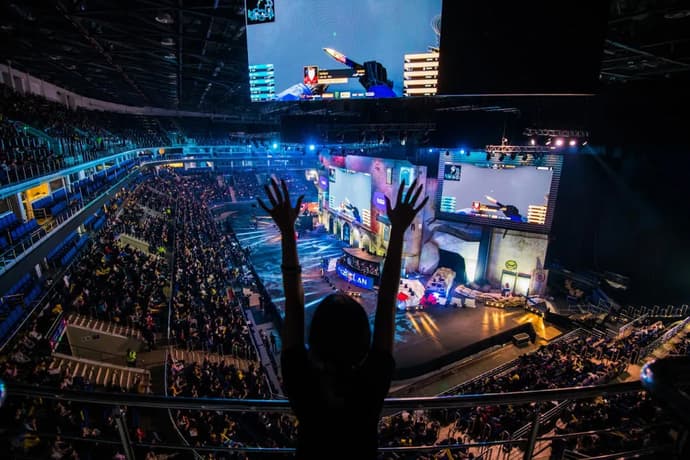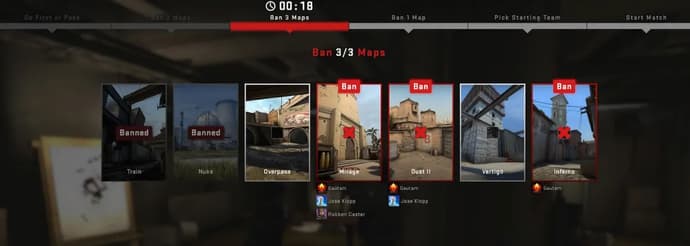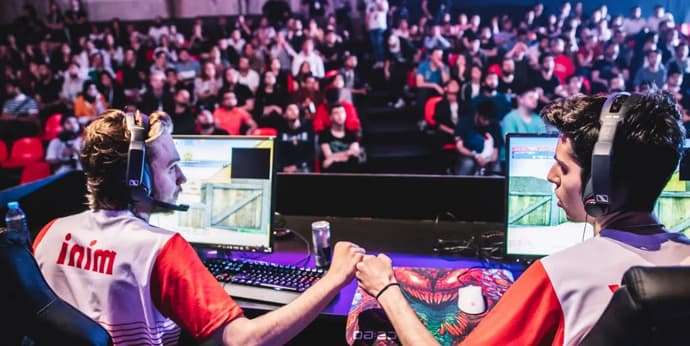
The rules of CS:GO matches on PRO-tournament

CS:GO has been a well-established discipline for a long time, which operates by strict rules. At least, all features are limited by the game that provides particular requirements for one or another team to achieve victory.
However, as soon as we talk about big CS:GO tournaments and the professional level, other conditions must be followed by teams. In such a way, there is a particular set of rules of CS:GO matches that work from match to match and from tournament to tournament.
So we would like to talk about these conditions and give some information about map selection, side swapping, amount of rounds, and overtime. Everything has its order, so let’s start from small and discuss the rules in the agreed format.
Map selection (the pick/ban stage) in a CS:GO match

The system of map selection by team operates at any large tournament. Since the active pool includes seven maps (Mirage, Inferno, Nuke, Overpass, Vertigo, Ancient, and Anubis), some of them will not appear in the series.
Since a few formats (BO1, BO3, and BO5) are used in CS:GO matches nowadays, it is worth taking a look at all of them.
In the first case, the favorite team chooses to ban a map first or receive the right to choose a side or to let an opponent make a choice instead. The interesting thing is that in this case, the first team bans only one map but every team removes two maps after that. The last turn also eliminates one map while the next participant chooses a side.
Recommend to read:
- Wallhack – Key console commands for X-ray vision in games.
- CSGO commands – Uncover the commands and cheat codes that gamers love the most for their utility.
- CSGO commands for FPS – Game-changing tips to raise your FPS and enjoy lag-free gaming.
If we consider the BO3 format, there are two formats of seeding determination:
- According to the established rating;
- According to the tournament schedule.
Describing the first case, an outsider team can ban a map and choose its pick first but at the same time, a favorite will choose a possible decider. In the second case, a team that has a higher seeding but made it through the lower bracket will have the right to make a first pick.
The situation with the BO5 format in CS:GO matches is even simpler. If we do not consider the handicap conditions, the team to make it to the grand final through the lower bracket will pick a map first. After that, teams choose in order until the pool of the whole match is determined.
Also, the important condition of the stage of map selection is the fact that the team that plays on an opponent’s pick will have the right to choose a more appropriate side. This format is due to offset a possible difference between participants on a particular map and make it different for a home team because it will have to start as an attacking side in 99% of cases.
Side-switching on a map
Going to the next rules that directly relate to side switching. Taking an average match as an example, a map consists of 30 rounds — 15 rounds both for attack and defense.
The interesting thing is that teams always play the required minimum of 16 rounds that is necessary to win a map. In such a way, side switching will happen mandatorily in every match — as soon as the first 15 rounds are played.
After that, the situation depends on a particular balance on the server because a map can be over in 16 rounds or even way later.
As soon as side swapping happens, teams will change their roles. If one team starts a match in attack, it will continue playing as a defense. Respectively, after side swapping, all the economy resents and players begin with $800 in their pockets.
Conditions to win a match

As it is written above, those who win 16 rounds first will prevail.
To win a round, a team needs to:
- eliminate all opponents;
- plant or defuse a bomb;
- wait till the end of the timer (in case of playing for defense).
There are other cases when technical issues emerge and a team has to finish a match. Then, the second team achieves a technical victory and the eliminated participant suffers a technical loss.
However, there are situations when teams can’t decide the favorite in 30 rounds. Participants have to play overtime rounds that can last forever, or till one of the teams gets tired.
How overtime rounds are played
Currently, there are separate systems of overtime rounds, each of which differs шт the sum of money given at the beginning of every overtime series. For example, we can notice three formats: $10,000, $12,500, and $16,000.
The first and third options probably cause a negative reaction among analysts and players but the second system is more and more frequently used at big championships due to its uniqueness.
However, the overall idea of overtime rounds does not change — teams are provided with unlimited series, each of which includes six rounds (three for each side).
The winning condition in overtime is the absolute majority of winning rounds. For example, a team has to win four rounds out of six.
However, if participants can’t determine the strongest one, they will continue playing the second, third and more series until the winner is determined. History knows enough cases when teams managed to play almost the whole BO5 series on one map with all the ensuing consequences.
The longest match in the history of the professional scene is the map Inferno between the teams XENEX and exceL. In 2015, they had to play six overtime series in the group stage of ESL UK Premiership Spring 2015, considering the then system with 10 rounds in one overtime. In total, the British players played 88 rounds, which is still an all-time record.
In such a way, there are strict rules now, which are followed by every tournament operator while organizing championships. So an esports fan is unlikely to get confused while watching any match because he/she knows for sure how a match is played and what conditions are to achieve victory.

Elen Stelmakh is a creative individual dedicated to advancing gaming culture through articles and visual design. As a full-time EGamersWorld author and designer for a gaming website, Elen not only creates content but also infuses it with energy and creativity.
 StarRupture Water Locations & SourcesStruggling with hydration on Arcadia-7? Learn how to get water in StarRupture by finding Hydrobulbs and crafting advanced Aqua items.
StarRupture Water Locations & SourcesStruggling with hydration on Arcadia-7? Learn how to get water in StarRupture by finding Hydrobulbs and crafting advanced Aqua items.
 How to Use Drones in StarRupture: Unlocking, Control & BuildingThis StarRupture Drone Guide covers how to unlock the essential Building Drone and automate your entire resource pipeline with an efficient rail network, including all upgrades and management tips.
How to Use Drones in StarRupture: Unlocking, Control & BuildingThis StarRupture Drone Guide covers how to unlock the essential Building Drone and automate your entire resource pipeline with an efficient rail network, including all upgrades and management tips.
 How To Build in StarRupture: Complete Unlocking GuideMy StarRupture Building Guide details every unlock and the best strategies for creating efficient, defensible bases.
How To Build in StarRupture: Complete Unlocking GuideMy StarRupture Building Guide details every unlock and the best strategies for creating efficient, defensible bases.
 How To Craft in Hytale: Recipes You Need For BeginningA complete guide to Hytale Crafting. Learn pocket crafting, workbenches, and all the essential recipes to get started.
How To Craft in Hytale: Recipes You Need For BeginningA complete guide to Hytale Crafting. Learn pocket crafting, workbenches, and all the essential recipes to get started.



